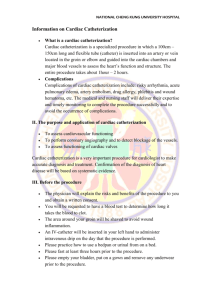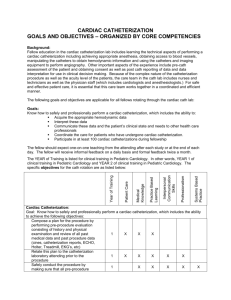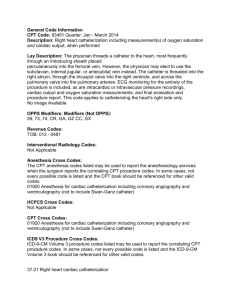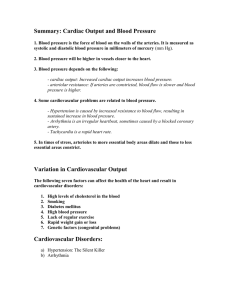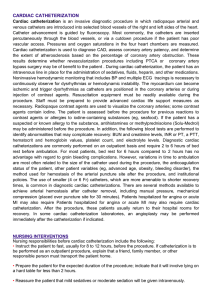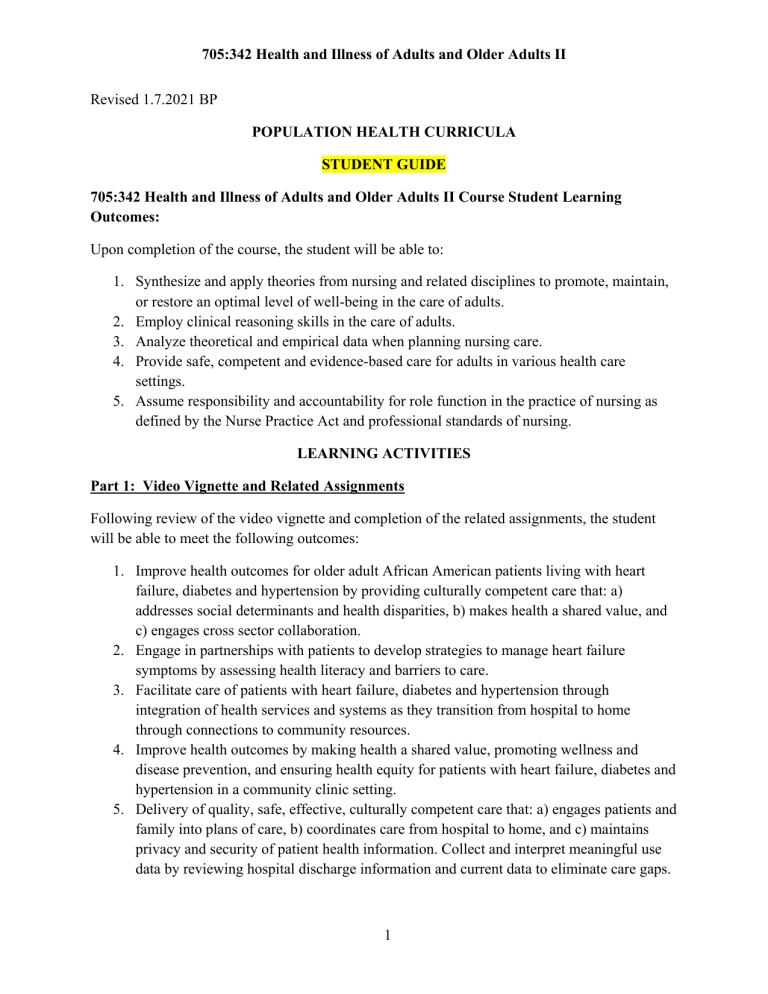
705:342 Health and Illness of Adults and Older Adults II Revised 1.7.2021 BP POPULATION HEALTH CURRICULA STUDENT GUIDE 705:342 Health and Illness of Adults and Older Adults II Course Student Learning Outcomes: Upon completion of the course, the student will be able to: 1. Synthesize and apply theories from nursing and related disciplines to promote, maintain, or restore an optimal level of well-being in the care of adults. 2. Employ clinical reasoning skills in the care of adults. 3. Analyze theoretical and empirical data when planning nursing care. 4. Provide safe, competent and evidence-based care for adults in various health care settings. 5. Assume responsibility and accountability for role function in the practice of nursing as defined by the Nurse Practice Act and professional standards of nursing. LEARNING ACTIVITIES Part 1: Video Vignette and Related Assignments Following review of the video vignette and completion of the related assignments, the student will be able to meet the following outcomes: 1. Improve health outcomes for older adult African American patients living with heart failure, diabetes and hypertension by providing culturally competent care that: a) addresses social determinants and health disparities, b) makes health a shared value, and c) engages cross sector collaboration. 2. Engage in partnerships with patients to develop strategies to manage heart failure symptoms by assessing health literacy and barriers to care. 3. Facilitate care of patients with heart failure, diabetes and hypertension through integration of health services and systems as they transition from hospital to home through connections to community resources. 4. Improve health outcomes by making health a shared value, promoting wellness and disease prevention, and ensuring health equity for patients with heart failure, diabetes and hypertension in a community clinic setting. 5. Delivery of quality, safe, effective, culturally competent care that: a) engages patients and family into plans of care, b) coordinates care from hospital to home, and c) maintains privacy and security of patient health information. Collect and interpret meaningful use data by reviewing hospital discharge information and current data to eliminate care gaps. 1 705:342 Health and Illness of Adults and Older Adults II 6. Utilize the electronic health record (EHR) for documentation and reassessment that supports the integration of technology into practice. **Students must complete ALL assignments and learning listed in the Population Health Student Assignment Guide by the specified deadlines to earn five points (5%) toward the final course grade. CLICK HERE for STUDENT CHECKLIST A: Video Vignette with Standardized Patient (15 minutes) • • • • Patient summary: An 82 year-old female of Nigerian descent, with a history of heart failure, hypertension, type 2 diabetes, and dilated cardiomyopathy was recently discharged from the 24-hour observation unit at her community hospital for c/o DOE. Patient was diagnosed with acute exacerbation of heart failure, was treated, and discharged with outpatient follow up in 1 week at the heart failure clinic. Setting: Community Health Clinic See video at [click hyperlink]: Adult II Video Vignette Clinic Note: Must have internet access to view video. Scroll down to see full video screen. Review the video vignette, take notes, and be prepared to discuss the: o Potential gaps that may occur when transferring patients between levels of care, and how these gaps may impact the ability to provide safe, effective care to patient populations. o Socioeconomic, cultural and financial barriers that may interfere with this patient’s ability to manage their heart failure. B: Video Vignette Pre-Class Assignment (60 minutes) The student must complete the following assignments prior to class: • • • • • • Review the electronic health record Patient Discharge Summary from previous hospitalization Watch “Educational Video: Congestive Heart Failure” video (4:06 minutes) at: https://www.youtube.com/watch?v=JWnCWCfBqDs (first video only) Watch “Living with Heart Failure – A Guide for Patients” (15:02 minutes) at https://www.youtube.com/watch?v=tP79YHgMmMg Read about the Institute for Healthcare Improvement (IHI) Triple Aim Initiative at: http://www.ihi.org/engage/initiatives/tripleaim/pages/default.aspx Read “About CAHPS,” go to: http://www.ahrq.gov/cahps/about-cahps/index.html Review the About the CAHPS Cultural Competence Item Set and the About Health Literacy Item Set [click on hyperlinks to download] and bring to class C: In-Class Debriefing and Activities (75 to 90 minutes) 2 705:342 Health and Illness of Adults and Older Adults II • Faculty will give instructions in class. Part 2: High Fidelity Simulation and Related Assignments Following participation in the high fidelity simulation and completion of the related assignments, the student will be to meet the following outcomes: 1. Improve health outcomes for older adult African American patients living with heart failure, diabetes and hypertension by providing culturally competent care that: a) addresses social determinants and health disparities, b) makes health a shared value, and c) engages cross sector collaboration. 2. Engage in partnerships with patients to develop strategies to manage heart failure symptoms by assessing health literacy and barriers to care. 3. Facilitate care of patients with heart failure, diabetes and hypertension through integration of health services and systems as they transition from outpatient cardiac catheterization unit to home and community. 4. Improve health outcomes by making health a shared value, promoting wellness and disease prevention, and ensuring health equity for patients with heart failure, diabetes and hypertension discharged from outpatient cardiac catheterization unit to home and community. 5. Delivery of quality, safe, effective, culturally competent care that: a) engages patients and family into plans of care, b) coordinates care from outpatient cardiac catheterization unit to home, and c) maintains privacy and security of patient health information. 6. Utilize the electronic health record (EHR) for documentation and reassessment that supports the integration of technology into practice. **Students must complete ALL assignments and learning activities listed in the Population Health Student Assignment Guide by the specified deadlines to earn five points (5%) toward the final course grade. CLICK HERE for STUDENT CHECKLIST A: High Fidelity Simulation On-Site Clinical Pre-Assignment (60 minutes) The student must complete the following assignments prior to the high fidelity simulation: • • Review Cardiovascular Function, Hemodynamics and Nursing Management post cardiac catheterization (see textbook or other reliable, peer-reviewed reference, i.e., UpToDate® as needed). Identify three (3) priority actions by the nurse receiving a patient post cardiac catheterization. Include rationale or evidence from the literature to support your nursing actions as priorities. 3 705:342 Health and Illness of Adults and Older Adults II • • Review the About the CAHPS Cultural Competence Item Set and the About Health Literacy Item Set [click on hyperlinks to download] and bring to scheduled simulation Complete the following and bring this written information to the scheduled simulation day: o Develop a discharge plan for the patient that provides evidence for engagement of patient and family, making health a shared value. Using IDEAL Discharge Planning from Agency for Healthcare Research and Quality as outlined below, discuss strategies that will help to achieve the goals to improve population health, well-being and health equity. Include the patient and family as full partners in the discharge planning process. Discuss best practices to partner with patients in developing strategies for symptom management. Identify what is significant about the patient’s past medical history (PMH) that might contribute to an individualized plan of care. Discuss with the patient and family five key areas to prevent problems at home: 1. Describe what life at home will be like 2. Review medications 3. Highlight warning signs and problems 4. Explain test results 5. Make follow up appointments • Educate the patient and family in plain language about the patient’s condition, the discharge process, and next steps throughout the hospital stay. Note: Refer to the About the CAHPS Cultural Competence Item Set and the About Health Literacy Item Set [click on hyperlinks to download]. Make sure to address culturally competent care for this older adult African American female by identifying key determinants for improving health and ways to reduce health disparities. Consider whether possible home practices and/or complementary/alternative therapies might help support culturally competent care for this patient. • Assess how well the healthcare team explains the diagnosis, condition, and next steps in the patient’s care to the patient and family and use teach back. • Listen to and honor the patient’s and family’s goals, preferences, observations, and concerns. (Describe strategies for active listening, goal setting and addressing social determinants and health disparities that impede meeting patient and family’s goals, preferences and concerns.) Source: Retrieved from: http://www.ahrq.gov/sites/default/files/wysiwyg/professionals/systems/hos pital/engagingfamilies/strategy4/Strat4_Tool_1_IDEAL_chklst_508.pdf 4 705:342 Health and Illness of Adults and Older Adults II • Have EHR Go! student account activated and preview student orientation video. B: Orientation/Pre-Conference (1 hour) • Orientation to simulation setting and discussion of pre-assignment for each clinical group C: High Fidelity Simulation (2 hours) • • • Patient summary: This is an 82 year-old female of Nigerian descent with a history of heart failure, hypertension, type 2 diabetes, and dilated cardiomyopathy. Several months have gone by since you last saw her in the emergency department. She has been followed in the heart failure clinic since that discharge. Recently, the patient went to the emergency department for evaluation due to increasing SOB and intermittent substernal chest pain with limited activity. Exam showed no EKG changes and troponin levels were negative. Her medications were adjusted, she was discharged to home, and sent for outpatient cardiac catheterization. Cardiac catheterization showed minimal CAD and dilated cardiomyopathy with LVEF 20%. You are the nurse in the recovery unit and have received this patient post cardiac catheterization. You will care for this patient until her discharge and must facilitate the transition from the outpatient cardiac catheterization unit to home. Current vital signs: BP 132 / 84 mmHg, HR 96 bpm, resp rate 18 / minute, Oral temp 98.8 F, Pulse Ox 94% on 4 L/NC and are due to be repeated at this time. Setting: Outpatient cardiac catheterization unit See instructions and schedule posted on course learning management system D: Post-Simulation Debriefing (1 hour) The Center for Clinical Learning team member will lead the debriefing on the topics and questions for each clinical group with assistance by the clinical instructor. 5
